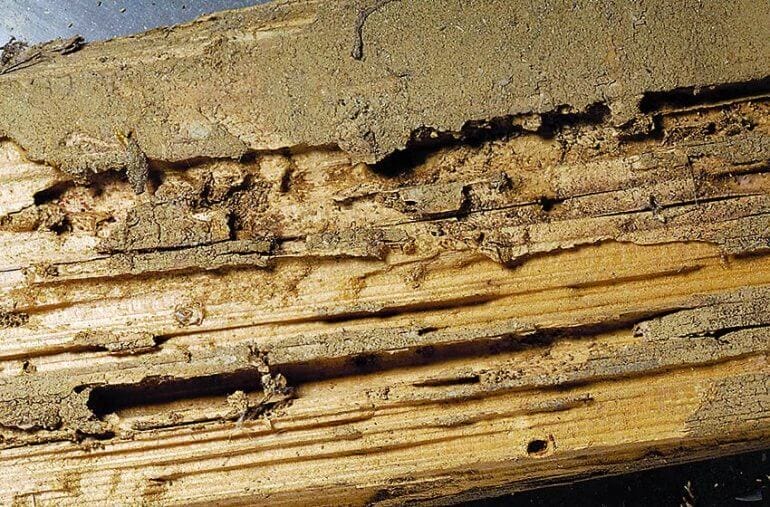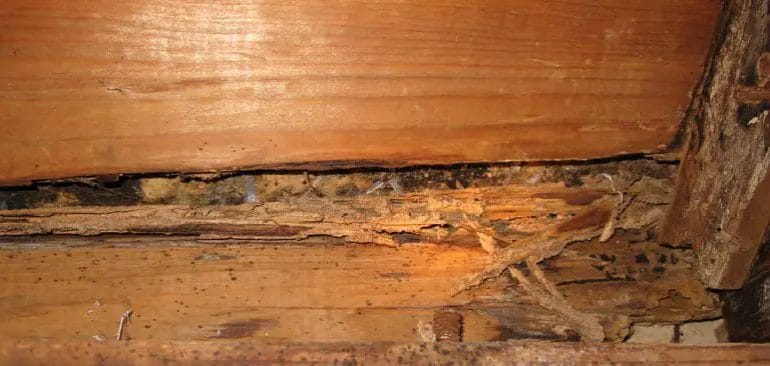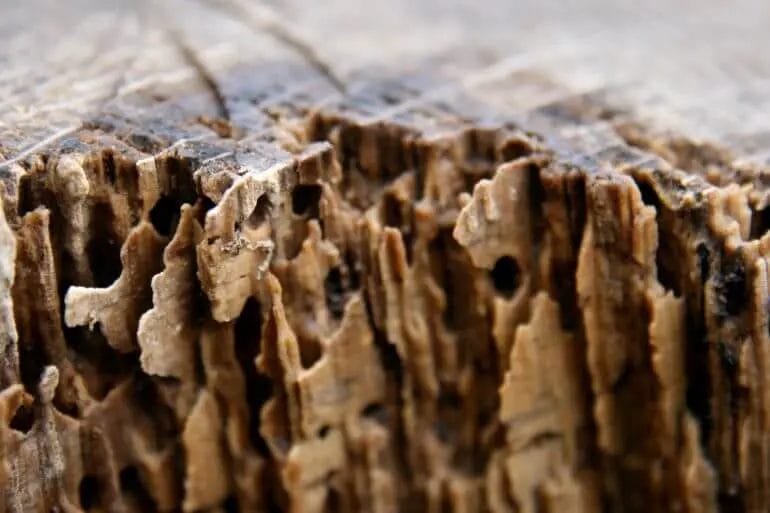If you’ve discovered termite damaged wood in your home, you might be wondering whether it needs to be removed. The answer depends on the severity of the damage. In some cases, you may be able to repair or treat the affected wood. However, if the damage is extensive or poses a structural risk, removal may be necessary. Taking prompt action is crucial to prevent further infestation and ensure the safety of your property. Read on to learn more about dealing with termite damaged wood and the best course of action to take.

Impact of Termite Damage on Structural Integrity of Wood
Termites are small insects that feed on wood and can cause significant damage to the structural integrity of wooden structures, such as buildings, furniture, and wooden fixtures. The presence of termites and their continuous feeding can weaken the wood, leading to potential safety hazards and costly repairs.

When termites infest wood, they burrow through the material, creating tunnels and galleries. These tunnels weaken the structure by compromising its strength and stability. Over time, if left untreated, termite damage can cause wood to become brittle and susceptible to collapse.
One of the main concerns with termite damage is that it is often hidden from plain sight. Termites work from the inside out, feeding on the cellulose within the wood while leaving the exterior intact. This means that by the time signs of termite infestation become noticeable, significant damage may have already occurred.
The extent of the damage depends on various factors, including the type of wood, the duration of infestation, and the size of the termite colony. In severe cases, termite damage can compromise the structural integrity of load-bearing beams, floors, and walls, posing a serious risk to the occupants of the affected building.
Termites are particularly attracted to moist and decaying wood, making areas with moisture issues more susceptible to infestation. Common locations for termite damage include basements, crawl spaces, and areas with plumbing leaks or poor ventilation.
It’s important to note that termite damage is not limited to buildings alone. Outdoor wooden structures, such as decks, fences, and pergolas, are also at risk. If these structures are compromised by termites, they may become unstable and unsafe for use.
Early detection and prevention are crucial in mitigating the impact of termite damage on the structural integrity of wood. Regular inspections by pest control professionals can help identify signs of termite activity and allow for prompt treatment. Additionally, taking measures to reduce moisture levels and maintain proper ventilation can create a less inviting environment for termites to thrive.
In summary, termite damage can have a detrimental effect on the structural integrity of wood. It weakens the wood by creating tunnels and galleries, leading to potential safety hazards and costly repairs. Detecting and preventing termite infestation is key to preserving the structural integrity of wooden structures and ensuring the safety of occupants.

Steps to Remove Termite Damaged Wood and Prevent Further Infestation
Termite infestations can wreak havoc on your property, causing significant damage to wooden structures. If you have identified termite damage in your wood, it is crucial to take immediate action to prevent further infestation and protect your property. In this section, we will outline the steps you need to follow to remove termite damaged wood and prevent future infestations.
1. Identify the Extent of Damage
The first step in removing termite damaged wood is to assess the extent of the damage. Carefully inspect the affected area to determine the severity of the infestation. Look for telltale signs such as hollowed or papery wood, mud tubes, or live termites. This will help you understand the scope of the problem and plan your removal strategy accordingly.
2. Consult with a Professional
While minor termite damage can be addressed by homeowners, severe infestations may require the expertise of a professional pest control company. Consult with an experienced exterminator who can assess the situation and provide guidance on the best course of action. They will have the necessary tools, knowledge, and treatments to effectively eliminate termites and prevent future infestations.
3. Remove Infested Wood
Once you have determined the extent of the termite damage, it is essential to remove the infested wood promptly. Start by wearing protective gear such as gloves and a mask to avoid any contact with harmful particles. Carefully remove the damaged wood, making sure to dispose of it properly to prevent any remnants from attracting new termites.
4. Treat the Surrounding Area
After removing the termite damaged wood, the next step is to treat the surrounding area to eliminate any remaining termites or eggs. This can be done using termiticides or other approved treatments. Follow the instructions provided by the pest control professional or product manufacturer to ensure effective results.
5. Repair or Replace Damaged Structures
With the infested wood removed and the area treated, it is time to repair or replace the damaged structures. Depending on the severity of the termite damage, you may need to seek the assistance of a professional carpenter or contractor to restore the affected areas. Proper repairs are essential to prevent future termite infestations and ensure the structural integrity of your property.
6. Implement Preventive Measures
To avoid future termite infestations, it is crucial to implement preventive measures. Here are some steps you can take:
- Regularly inspect your property for signs of termites or termite damage.
- Keep wood away from direct contact with the soil.
- Seal any cracks or gaps in the foundation and walls of your property.
- Ensure proper ventilation in your property to prevent moisture buildup, which attracts termites.
- Trim vegetation and shrubs away from the exterior walls of your property to eliminate potential termite entry points.
- Consider using termite-resistant materials when building or renovating.
Summary
Termite infestations and damage to wooden structures can be a major concern for homeowners. By following the steps outlined in this section, you can effectively remove termite damaged wood and prevent further infestations. Remember to assess the extent of the damage, consult with professionals if needed, remove infested wood, treat the area, repair or replace damaged structures, and implement preventive measures. Taking prompt action and adopting preventive measures will help safeguard your property from the destructive impact of termites.

Effective Treatments and Solutions for Termite Infested Wood
When it comes to dealing with termite infested wood, it’s important to act quickly and effectively to prevent further damage. Termites can wreak havoc on wooden structures, causing extensive damage if left untreated. In this section, we will explore some of the most effective treatments and solutions for termite infested wood.
1. Chemical Treatments
Chemical treatments are one of the most common methods used to eliminate termites and protect infested wood. There are several types of chemical treatments available, including:
- Liquid termiticides: These are applied to the soil around the infested area or directly onto the wood to create a barrier that repels or kills termites.
- Bait systems: Bait stations are strategically placed around the infested area to attract termites. The termites feed on the bait and carry it back to their colony, effectively eliminating the entire population.
- Wood treatments: Wood preservatives containing chemicals like borates are applied directly to the infested wood to kill termites and prevent future infestations.
Chemical treatments should always be carried out by a professional pest control company to ensure proper application and safety.
2. Heat Treatment
Heat treatment is another effective solution for termite infested wood. This method involves using high temperatures to kill termites and their eggs. The infested wood is placed inside a heat chamber, where the temperature is gradually raised to a level that is lethal to termites.
This method is environmentally friendly and eliminates the need for chemicals. However, it may not be suitable for all types of wood or structures, so it’s important to consult with a professional to determine if heat treatment is a viable option.
3. Freezing
Freezing is a unique approach to treating termite infested wood. This method involves exposing the infested wood to extremely low temperatures, typically below -20 degrees Celsius. The cold temperature kills the termites and their eggs, effectively eliminating the infestation.
Freezing can be an effective treatment option, especially for small infestations. However, it may not be suitable for larger or heavily infested structures.
4. Fumigation
Fumigation is a powerful treatment method that involves using gas to eliminate termites. The infested wood is sealed in a tent and a fumigant gas, such as sulfuryl fluoride, is released into the enclosed space. The gas permeates the wood, killing termites and their eggs.
Fumigation is typically used for severe infestations or when other treatment options have failed. It requires specialized equipment and should only be performed by trained professionals.
5. Prevention Strategies
Prevention is key to avoiding termite infestations in the first place. Here are some effective strategies to prevent termites from attacking your wooden structures:
- Regular inspections: Conduct regular inspections of your property to detect any signs of termite activity early on.
- Remove wood debris: Eliminate any wood debris or cellulose materials near your property, as they can attract termites.
- Proper ventilation: Ensure proper ventilation in attics, basements, and crawl spaces to reduce moisture levels, which termites thrive in.
- Seal cracks and gaps: Seal any cracks or gaps in your foundation, walls, and windows to prevent termites from entering your property.
- Use termite-resistant materials: Consider using treated or naturally termite-resistant wood for construction and renovations.
By implementing these preventive measures, you can significantly reduce the risk of termite infestations and protect your wooden structures.
Professional Inspection and Restoration Services for Termite Damaged Wood
Termites are silent invaders that can wreak havoc on the structure of your home or property. They feed on wood and can cause significant damage if left unchecked. When it comes to dealing with termite damaged wood, it is essential to enlist the help of professional inspection and restoration services to ensure effective treatment and long-term protection.
Termite damage can be extensive and may compromise the structural integrity of a building. Therefore, it is crucial to identify and address the issue promptly. Professional inspection services specialize in identifying termite activity and assessing the extent of the damage. They have the knowledge, experience, and tools to perform a thorough inspection, including accessing hard-to-reach areas and identifying hidden colonies.
During the inspection, the professionals will determine the type of termite infestation and the extent of the damage. They will assess the affected wood, including beams, wooden furniture, flooring, and walls. Using advanced detection methods such as moisture meters and infrared cameras, they can pinpoint areas of infestation and identify any underlying structural issues.
Once the inspection is complete, the restoration process begins. Professional restoration services have the expertise to restore termite damaged wood effectively. They will develop a comprehensive plan that includes the removal and replacement of infested wood, treating the affected areas, and implementing preventive measures to prevent future infestations.
The restoration process typically involves the following steps:
- 1. Removal of Infested Wood: The first step is to remove the termite-infested wood carefully. This may involve dismantling affected structures, such as cabinets or flooring, to ensure all infested areas are identified and removed.
- 2. Treatment of Affected Areas: After removing the infested wood, the professionals will treat the surrounding areas to eliminate any remaining termites or eggs. This may involve using environmentally friendly termiticides to ensure complete eradication.
- 3. Replacement of Damaged Wood: Once the affected areas are treated, the next step is to replace the damaged wood. The professionals will use high-quality, termite-resistant materials to ensure long-lasting results.
- 4. Preventive Measures: To prevent future infestations, the restoration services may recommend installing physical barriers, such as termite shields or treated wood, to deter termites from reinfesting the area. Regular inspections and maintenance are also essential to detect any signs of termite activity early on.
In summary, professional inspection and restoration services play a vital role in addressing termite damaged wood. They have the expertise, tools, and techniques to identify and treat termite infestations effectively. By enlisting their services, you can ensure the structural integrity of your property and protect it from further termite damage. Don’t let termites destroy your valuable assets; take action today and seek professional assistance to restore and safeguard your property.
FAQs
Does termite damaged wood need to be removed?
Yes, termite damaged wood should be removed. Termites can weaken the structure of wood, making it unsafe and susceptible to further damage. Removing and replacing the damaged wood is necessary to ensure the structural integrity of the building.
Conclusion
In conclusion, termite damaged wood should be promptly removed to prevent further infestation and structural damage. Leaving the damaged wood untreated can lead to a continuous food source for termites, allowing them to thrive and potentially spread to other areas of the property.
Removing termite damaged wood also helps in identifying the extent of the infestation and allows for proper treatment and repairs. It is crucial to consult with a professional pest control company or a licensed contractor to assess the damage and provide effective solutions.
Remember, early detection and proactive measures are key to preventing long-term destruction caused by termites. So, don’t hesitate to take action and protect your property from these destructive pests.